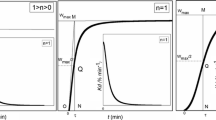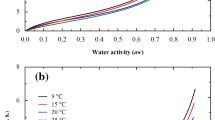Abstract
The purpose of this research was to elucidate the significance of the changes in the mechanical and the volumetric properties on the moisture diffusivity through the polymer films. The internal stress concept was adapted and applied to estimate the relative impact of these property changes on the total stress experienced by a polymer film during storage. Hydroxypropyl Methylcellulose free films were used as a model material prepared at various conditions and stored at different relative humidities. The changes in the internal stress of these films due to the moisture sorption were studied. It was demonstrated that the stress-relaxation of the films increases at increasing moisture content. At the point when there is a definite loss of stress in the film, which is at moisture content higher than 6%, was shown to correlate with the significant increase of the moisture diffusivity. Further investigations revealed that the loss of stress is especially due to the swelling of the polymer rather than the changes in the inherent strain (the quotient between the tensile strength and the modulus of elasticity) of the HPMC films. This implies that the impact of the moisture sorption on the diffusivity is predominantly via volume addition rather than via altering the mechanical properties. Additionally, the approach presented here also brings up a new application of the internal stress concept, which in essence suggests the possibility to estimate the diffusion coefficient from the sorption isotherm and the mechanical analysis data.






Similar content being viewed by others
Abbreviations
- A :
-
Film area [=] m2
- C avg :
-
Average moisture content [=] %-weight
- E :
-
Young modulus of elasticity [=] MPa
- P :
-
Internal stress [=] MPa
- S avg :
-
Average solubility of moisture in the total film [=] g/m3Pa
- T g :
-
Glass transition temperature of the coating material [=] K
- V :
-
Original volume of the core [=] m3
- WVP:
-
Water Vapor Permeability [=] g/m.Pa.s
- Δm:
-
Moisture gain at certain permeation time [=] g
- ΔP:
-
Difference of partial pressure of water vapor at two sides of the coating film [=] Pa
- ΔRH:
-
Gradient of the relative humidity [=] %
- Δt :
-
Time [=] s
- ΔT :
-
Difference between the glass transition temperature of the coating and the temperature of the film during process and storage [=] K
- ΔV :
-
Volumetric changes of the core [=] m3
- Δx:
-
Film thickness
- Δα(cubic) :
-
Difference in thermal expansion coefficient of the core and the coating material [=] K-1
- εi :
-
Internal strain [=] %
- εf :
-
Maximum strain before fracture [=] %
- εtotal :
-
Total strain [=] %
- ϕR :
-
Volumetric fraction of water retained in the film during storage [=] %
- ϕS :
-
Volumetric fraction of water at solidification point (during drying) [=] %
- υ:
-
Poisson ratio [=] -
- ρtrue :
-
True density [=] g/m3
- σ:
-
Stress [=] MPa
- σf :
-
Maximum tensile strength before fracture [=] MPa
- φ:
-
Degree of swelling [=] -
References
G. K. van der Wel, and O. C. G. Adan. Moisture in organic coatings—a review. Prog. Org. Coat. 37:1–14 (1999).
B. C. Hancock, and G. Zografi. The relationship between the glass transition temperature and the water content of amorphous pharmaceutical solids. Pharm. Res. 11:471–477 (1994).
S. Malamataris, and T. Karidas. Effect of particle size and sorbed moisture on the tensile strength of some tableted hydroxypropyl methylcellulose (HPMC) polymers. Int. J. Pharm. 104:115–123 (1994).
S. G. Croll. The origin of residual internal stress in solvent-cast thermoplastic coatings. J. Appl. Polym. Sci. 23:847–858 (1979).
K. Sato. The internal stress of coating films. Prog. Org. Coat. 8:143–160 (1980).
R. C. Rowe. A reappraissal of the equations used to predict the internal stresses in film coatings applied to tablet substrates. J. Pharm. Pharmacol. 35:112–113 (1983).
E. Okutgen, J. E. Hogan, and M. E. Aulton. Quantitative estimation of internal stress development in aqueous HPMC tablet film coats. Int. J. Pharm. 119:193–202 (1995).
E. Okutgen, J. E. Hogan, and M. E. Aulton. Effects of tablet core dimensional instability on the generation of internal stresses within film coats: III. Exposures to temperatures and relative humidities which mimic the film coating process. Drug Dev. Ind. Pharm. 17:2005–2016 (1991).
R. C. Rowe. The effect of pigment type and concentration on the incidence of edge splitting on film-coated tablets. Pharm. Acta Helv. 57:221–225 (1982).
A. O. Okhamafe, and P. York. Stress crack resistance of some pigmented and unpigmented tablet film coating systems. J. Pharm. Pharmacol. 37:449–454 (1985).
V. Coma, I. Sebti, P. Pardon, and F. H. Pichavant. Film properties from crosslinking of cellulosic derivatives with a polyfunctional carboxylic acid. Carb. Polym. 51:265–271 (2003).
F. Debeaufort, A. Voilley, and P. Meares. Water vapor permeability and diffusivity through methylcellulose edible films. J. Membr. Sci. 91:125–133 (1994).
M. A. Repka, and J. W. McGinity. Physical-mechanical, moisture absorption and bioadhesive properties of hydroxypropylcellulose hot-melt extruded films. Biomaterials. 21:1509–1517 (2000).
R. C. Rowe. The cracking of film coatings on film-coated tablets—a theoretical approach with practical implications. J. Pharm. Pharmacol. 33:423–426 (1981).
P. Stanley, R. C. Rowe, and J. M. Newton. Theoretical considerations of the influence of polymer film coatings on the mechanical strength of tablets. J. Pharm. Pharmacol. 33:557–560 (1981).
P. Colombo, R. Bettini, and N. A. Peppas. Observation of swelling process and diffusion front position during swelling in hydroxypropyl methyl cellulose (HPMC) matrices containing a soluble drug. J. Control. Release. 61:83–91 (1999).
C. A. Fyfe, and A. I. Blazek-Welsh. Quantitative NMR imaging study of the mechanism of drug release from swelling hydroxypropylmethylcellulose tablets. J. Control. Release. 68:313–333 (2000).
L. S. C. Wan, P. W. S. Heng, and L. F. Wong. Matrix swelling: a simple model describing extent of swelling of HPMC matrices. Int. J. Pharm. 116:159–168 (1995).
O. Honkanen. Biopharmaceutical evaluation of orally and rectally administered hard hydroxypropyl methylcellulose capsules. PhD Thesis, Faculty of Pharmacy of the University of Helsinki, Finland, 2004.
Acknowledgements
The authors would like to thank Ramona Prickaerts, Jasper Vollenbroek, and Albert van der Padt from Friesland Food Research Centre Deventer, The Netherlands for their assistance during the measurement of the moisture sorption isotherms in their facility.
Author information
Authors and Affiliations
Corresponding author
Rights and permissions
About this article
Cite this article
Laksmana, F.L., Kok, P.J.A.H., Frijlink, H.W. et al. Using the Internal Stress Concept to Assess the Importance of Moisture Sorption-induced Swelling on the Moisture Transport through the Glassy HPMC Films. AAPS PharmSciTech 9, 891–898 (2008). https://doi.org/10.1208/s12249-008-9128-7
Received:
Accepted:
Published:
Issue Date:
DOI: https://doi.org/10.1208/s12249-008-9128-7




